DEFENCE F-35B training
Lightning Pathfinders
Ahead of HMS Queen Elizabeth’s first operational cruise next year, ALAN WARNES goes behind the scenes with 207 Sqn RAF – the Operational Conversion Unit (OCU) responsible for turning UK pilots into F-35B fighter pilots and readying them for carrier strike.
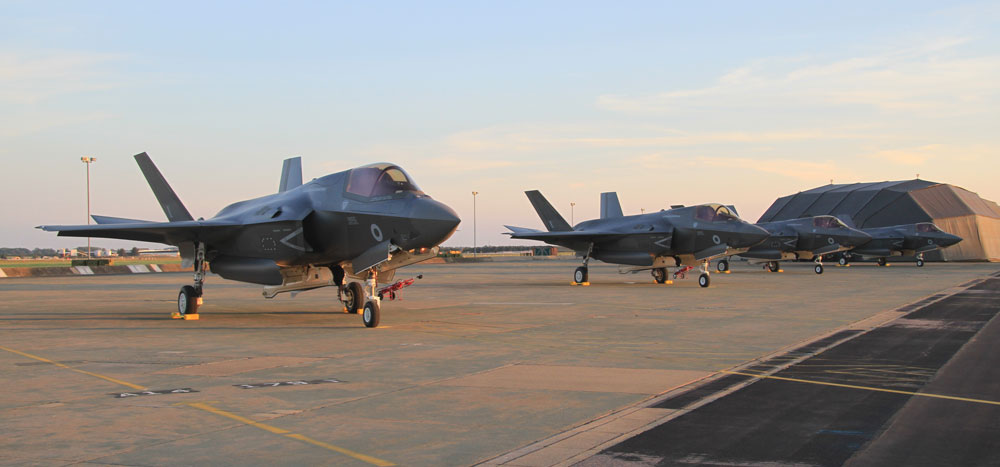 The F-35Bs arrived at RAF Marham in June 2018. Alan Warnes
The F-35Bs arrived at RAF Marham in June 2018. Alan Warnes
Don’t ever underestimate the difficulties of introducing new capabilities, particularly when they include the new F-35B Lightning on a new aircraft carrier as Alan Warnes has discovered.
Next year there will be a seismic shift in UK capabilities, when the HMS Queen Elizabeth aircraft carrier embarks upon its first operational tour – known as Carrier Strike Group 21 (CSG21). With it comes a plethora of new military systems but arguably the most important is the fifth generation F-35B Lightning II combat aircraft. All hands-are-now-on–deck (excuse the pun) to ensure they, like the rest of the aircraft are combat-ready when the ship slips anchor from Portsmouth in mid-2021.
Spearheading the F-35B’s introduction into service is the Lightning Force, a joint Royal Navy and RAF command organisation. There are currently two UK F-35B Lightning squadrons, 617 Squadron ‘The Dambusters’ and 207 Sqn based at RAF Marham, Norfolk. While 617 Sqn gets on with sharpening its operational capabilities, 207 Sqn is the F-35B Operational Conversion Unit. Air Cdre David ‘Bradders’ Bradshaw, previously Lightning Force Commander and now the RAF’s Head of UK Combat Air, said of 207: “As our F-35B training unit, the squadron qualifies its staff, instructs the front line pilots and eventually new ab-initio pilots as they come through the training system.”
There is a requirement for 138 F-35s and, to date, 48 F-35Bs have been approved. Eighteen have been delivered, three to Edwards AFB flying with 17 Sqn and 15 to RAF Marham. Another three are expected by the end of the year.
In late-2019, just 18 months after the first 617 Sqn F-35B Lightning IIs arrived in the UK, the embryonic F-35B Lightning Force was declared IOC (initial operational capability) – Land. Air Cdre Bradshaw explains as: “Deploying for any landbased warfighting missions directed by the UK Government.”
Having overcome that hurdle, the Air Cdre now has to guarantee IOC – Carrier by the end of 2020. “Our near-term focus is to ensure the Lightning Force can fight effectively from the Queen Elizabeth carrier. That’s why 207 Squadron deployed to the ship with its F-35Bs for Exercise Lightning Fury in late January for nearly two weeks.”
Working Up
Commanded by Wg Cdr Scott ‘Mox’ Williams, 207 Sqn deployed to the carrier on January 28, marking the culmination of a three-part work up. The unit had spent two weeks at BAE Systems Warton, Lancashire training at the F-35/Queen Elizabeth Carrier (QEC) Integration Simulator facility. This is here the cockpit of the F-35 and the flying control tower (FLYCO) on board HMS Queen Elizabeth are replicated to provide a complete 360-degree immersive experience for pilots. It has been used to simulate thousands of take-offs and landings and uses highly specialised computational engineering to model the air wake of the ship, which is the way air moves around and behind the carrier and flight deck, to replicate the motions that F-35 pilots will feel in real life.
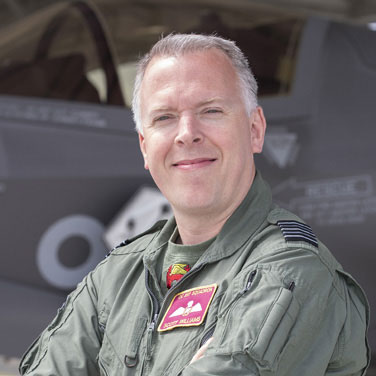 Wg Cdr Scott ‘Mox’ Williams, 207 Sqn (UK MoD)
Wg Cdr Scott ‘Mox’ Williams, 207 Sqn (UK MoD)
Wg Cdr Williams, who previously had three tours flying the Harrier GR7/9 before converting to Tornado GR4 and then F-35B in 2017, continued: “We also train LSOs in a separate room, which mimics the FLYCO part of the carrier. We have a person in the loop in the aircraft cockpit, with an LSO looking on in the simulated world from the FLYCO real-time. So any mistakes the pilots make, tests the supervision of the LSO. We get twice as much out of the training during an event when we go up there. It really immerses you into the ship environment day and night and recreates the real experience by more than 90%.”
Once the training at Warton was complete and all the personnel were fully conversant with flying from the ship, the unit returned to RAF Marham.
Back home the pilots trained on full mission simulators, bringing wider ship procedures into play that can’t be replicated at Warton. The unit then deployed to the ship to qualify seven instructors in day and night ops, while 617 Sqn qualified eight pilots in June during Carrier Qualification 2 (CQ-2) – four in day and night operations, and four day only. The remaining four will persevere with their night needs during the next carrier qualification (CQ) in September/ October.
In addition to qualifying instructors during Exercise Lightning Fury, the unit also checked-out an untested carrier syllabus. “We had to provide an objective Central Flying School (CFS) accredited view on the content and syllabus, to see how difficult it was and what pertinent lessons we could bring back and spread to the force”, Wg Cdr Williams said, then adding, “We also had to build the right supervision levels with our Landing Signals Officers (LSOs), allowing us to prepare and build 617 Sqn in preparation for their June CQ deployment. From a force perspective we were effectively pathfinders in generating core carrier flying skills for 617 to get them ready for going on CSG21 next year. That was key, because it is a massive force effort to generate a carrier capability.”
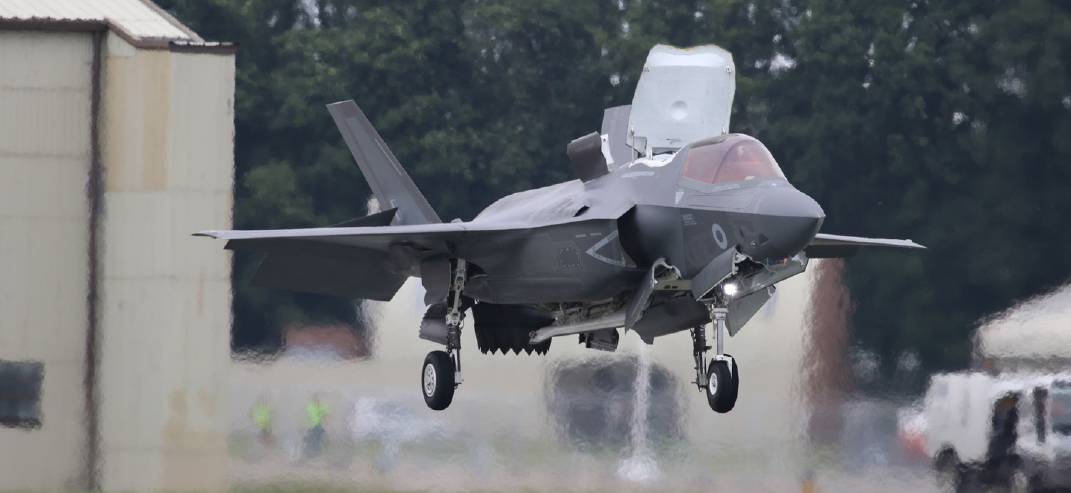 The F-35B in the the hover showing the doors and inlets for its LiftFan. Alan Warnes
The F-35B in the the hover showing the doors and inlets for its LiftFan. Alan Warnes
Lightning Operational Conversion Unit
No 207 Sqn is the Lightning Operational Conversion Unit, responsible for training pilots to fly the F-35B Lightning. Since standing up on 1 July 2019, much of the OCU’s time has been taken up training the broader F-35B force safely and effectively from the aircraft carrier. As an OCU there are many more Qualified Flying Instructors (QFIs) on the unit compared to an operational squadron and Qualified Weapons Instructors (QWIs) too. QFIs concentrate on teaching pilots to fly the F-35B and QWIs teach how to tactically use the weapons carried by the jet. On 207 Sqn, all of the instructor pilots are QFIs but there are three QWIs, including the OC; “I am a Harrier QWI, while the other two are from the Typhoon and Tornado GR4. We have the QWI qualification but it is not necessarily transferrable to being the tactical expert on F-35 that would be expected.” That won’t be the case for too much longer, as Wg Cdr Williams explained; “We will fix that in 2022 by running the first Lightning QWI course at RAF Marham in tandem with the Typhoon QWI course, allowing us to blend the 4th and 5th gen capabilities. It will run for 10-11 months and the product you get at the end of the course should be extremely good.”
Today there are currently eight QFIs on the unit, six are RAF and two RN but the latter are now growing and the mix should eventually be six/ four broadly in line with the official 58%-42% Joint Lightning Force split.
Eight ab-initio pilots, have progressed through the training stream, rather than from another front-line aircraft, to join the Lightning Force. The first four went through RAF Valley, flying the Hawk T2 in 2017 before being posted to VMFAT-501 at MCAS Beaufort, South Carolina where they converted to the F-35B. All four are now on the front line with 617 Sqn, two being candidates for the 2022 QWI course.
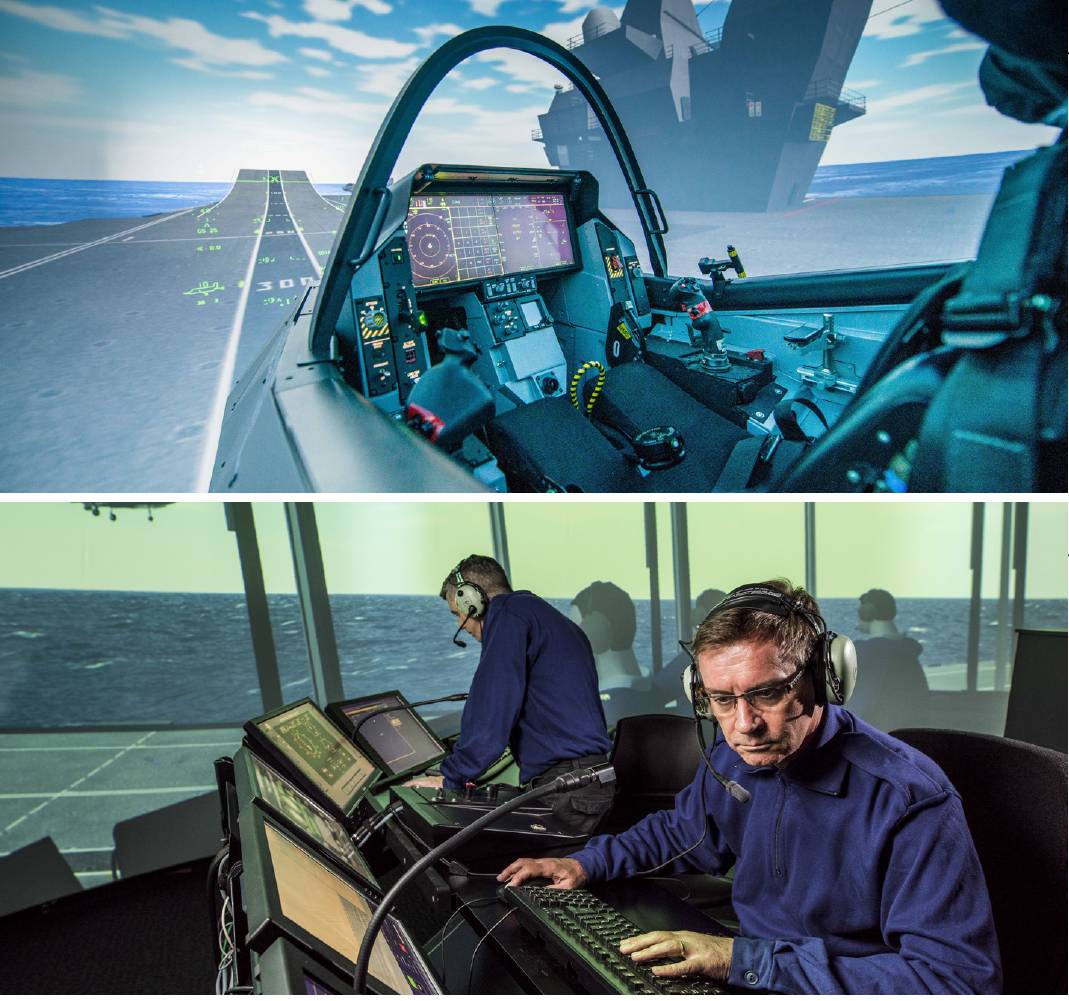 F-35B pilots also train on the F-35B/QEC simulator at the same time, before flying from the aircraft carrier. BAE Systems Bottom: The F-35B/QEC simulator at BAE Systems, Warton is where LSOs can practise their skills before going to the carrier. BAE Systems
F-35B pilots also train on the F-35B/QEC simulator at the same time, before flying from the aircraft carrier. BAE Systems Bottom: The F-35B/QEC simulator at BAE Systems, Warton is where LSOs can practise their skills before going to the carrier. BAE Systems
There are currently four ab-initio pilots progressing through 207 Sqn – two are well into their flying syllabus and the other pair have just started their ground school during early July.
Wg Cdr Williams commented, “We feed back to MFTS the essential attributes that we are looking for in students; namely good captaincy, high levels of mental capacity and the ability to fly accurately whilst operating a high-performance aircraft.”
When arriving at RAF Marham to join the Lightning Force, students undergo seven weeks of ground school at the Integrated Training Centre. In the facility, next door to the unit, pilots, engineers and mission support staff learn their trade. Pilot training aids (PTAs), essentially touch screen cockpit trainers – monitors with PCs and joy-stick/ throttle systems are essential tools. Then there is a four-week phase on full mission simulators (FMS) – with each student facing 20 different scenarios to build their knowledge. This includes practising the STOVL (short take-off and vertical landing) regime, so covering short take-offs, slow landings, rolling vertical landings and vertical landings on the pads. To make things a little easier when it comes to flying the aircraft, the FMS’ mirror RAF Marham’s layout.
Once completed, the students then face eight dedicated emergency simulations, like engine flame-out procedures. With a better than 1:1 glide ratio, the F-35 can glide pretty well, so they are taught the art of safely recovering an F-35B without a working engine! Wg Cdr Williams explained; “We want students to make a decision as to whether they have the energy to safely glide the jet back; if they can, great. If not, we want students to make a safe decision to eject.”
Completing the simulation work culminates in an emergency procedures validation (EPVal). Until then, pilots have been taught by contracted BAE instructor pilots at the ITC. Come the EPVal, a military instructor steps in for the first time, to check the student’s emergency and general handling capabilities and, if that’s not at the level expected, they will get more time. An instrument rating test immediately follows and, if they pass both, they rejoin 207 Sqn to commence live flying on the F-35B. “Once the students have successfully completed the EPVal and general handling check they then become part of the unit. Until then they may have worn a 207 Sqn patch but will only have joined us at social events.”
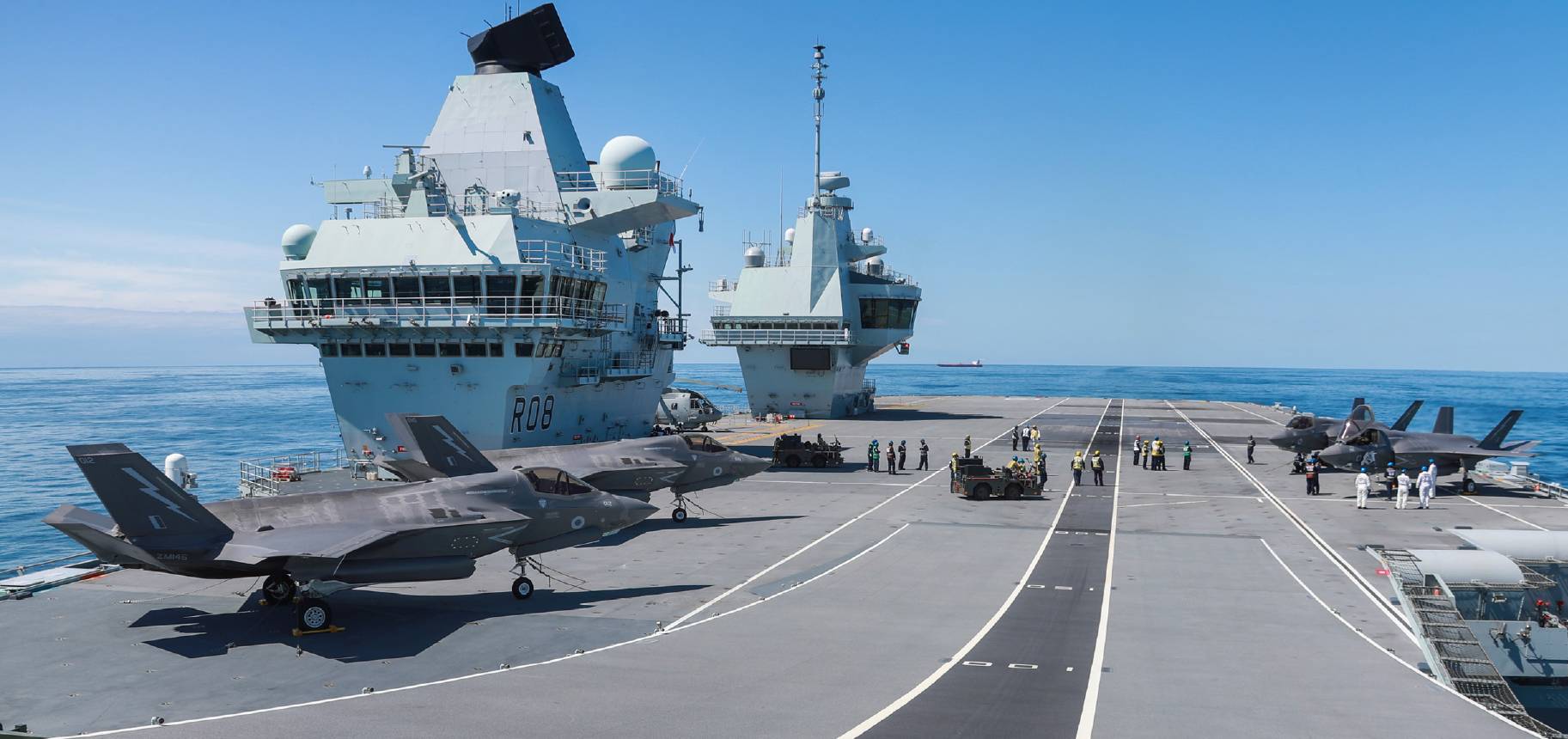 Ensuring the F-35B is qualified to operate from the Queen Elizabeth aircraft carrier is a major landmark for the fifth gen jet. UK Mod
Ensuring the F-35B is qualified to operate from the Queen Elizabeth aircraft carrier is a major landmark for the fifth gen jet. UK Mod
Landing on a carrier
You might have thought being an ex-Harrier GR7/9 pilot would be an advantage when flying the F-35B but Wg Cdr Williams didn’t necessarily agree; “only 5% of what I learnt flying the STOVL Harrier is any use on the STOVL F-35B.”
He continued; “One thing is for sure, it’s much easier flying a F-35 onto a carrier than a Harrier. I flew day and night ops from the HMS Illustrious and HMS Invincible in my Harrier days. Landing at night with winds up to 35 knots with bad weather and limited visibility on a big pitching deck is the scariest thing I’ve ever done in an aircraft! It was all so manual, with the stick, throttle and nozzle controls needing frequent adjustment.”
Wg Cdr Williams added; “In the F-35B you could take your hands off the the aircraft’s controls in the hover day or night while alongside the ship and, as long as you have set the system up correctly the aircraft will hardly move.”
The shipborne rolling vertical landing (SRVL) concept, as the system is termed, was invented by the UK on the VAAC (Vectored Thrust Aircraft Advanced Control) Harrier, which was proved during trials aboard the French Navy’s Charles de Gaulle carrier in 2007. When returning to the carrier, an operational airborne Harrier would normally pull up beside the ship and then hover sideways across the deck and land, just as the F-35 does. SRVL allows the aircraft to keep the forward speed, with the onboard computers able to help the jet create wing lift. At the same time, the thrust from its engine and lift fan creates the forward momentum that can directly translate to a bring back capability. This allows the aircraft to accomplish a slow landing speed of 57 knots and the ability to return with more weapons and fuel, especially in hot temperatures.
The SRVL system is intrinsically designed into the F-35B’s control laws, so if you press the button to go from conventional flight to STOVL, all the aircraft’s [engine] doors open up, as Wg Cdr William explains; “Below approximately 45kt air speed you enter the jet borne flight regime and the flight controls behave slightly differently. For instance, pulling or pushing the stick no longer commands a pitch rate but instead commands a vertical climb or descent rate. Applying rudder pedal input generates side-slip ordinarily but in jet borne flight it commands a yaw rate. Throttle movement demands acceleration forward or rearwards from a central detent position.”
It was a different story on the Harrier, as the OC explains; “With Harrier you controlled height with the throttle – a little power off and back on to descend. However, if you tried that in F-35 – where, as explained, the throttle controls forward and backward movement – you’d end up darting forwards or backwards. So, having other STOVL aircraft handling experience can be rather counterproductive.”
The Wg Cdr admitted that landing the F-35 on a carrier at night is one of the most challenging things from a handling perspective. “But there are lots of things we do tactically that are more challenging for the pilots as they come through.”
 The F-35Bs arrived at RAF Marham in June 2018. Alan Warnes
The F-35Bs arrived at RAF Marham in June 2018. Alan Warnes


